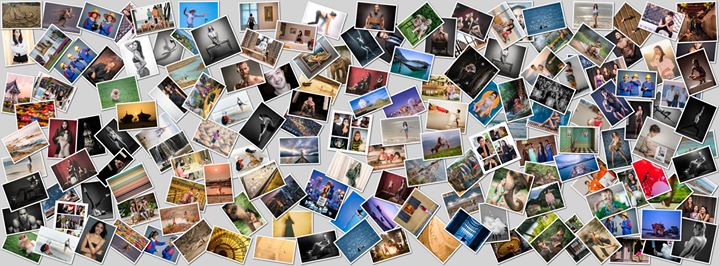-
Posts
778 -
Joined
-
Last visited
Reputation Activity
-
 Robert Collins got a reaction from kaylee in Artistic / aesthetic use of Bokeh?
Robert Collins got a reaction from kaylee in Artistic / aesthetic use of Bokeh?
Bokeh or out of focus areas aesthetically add depth to photo or video. Depicting depth is important because essentially you are trying to depict a 3D scene in a 2D format.
Essentially bokeh to a certain extent mimics 'aerial perspective. Aerial perspective is the concept that we view things as being further away if they have less contrast, detail and saturation.
Here is a random example off the internet...
Essentially we can 'see' a range of hills further and further in the distance.
If you consider that bokeh is essentially 'blurring' the background it is creating the illusion of aerial perspective and depth. The bokeh/blurring clearly reduces detail, reduces contrast (by merging the highlights, mid tones and shadows, and reducing saturation (by merging highly saturated areas with less saturation.) (of course you could achieve a similar effect by adding smoke to your background.)
-
 Robert Collins got a reaction from Emanuel in Sony a7 III discussion
Robert Collins got a reaction from Emanuel in Sony a7 III discussion
This is with the Batis 85. It is a 'still' from a 14bit raw file so you can obviously process how you want unlike the 100mb/s 8 bit video where your ability to process is very limited.
Here are a couple of straight out of camera jpegs (8 bit) to show how the Sony renders by default.
This is the original jpeg of the earlier photo....
And this is another straight out of camera jpeg. So you can see that Sony renders its jpegs with a lot of contrast, saturation and a lot of sharpening which is different to Jon's video grab (and most video). I also think the Sony has a tendency towards slightly cartoonish colors.
Theoretically you can match the video to stills with PP2 (still) from the video picture profiles. My guess is that most people wouldnt go down that route.
-
 Robert Collins got a reaction from kye in Sony a7 III discussion
Robert Collins got a reaction from kye in Sony a7 III discussion
I only think that this is half right. Sony gives quite a lot of leeway in its video profiles to produce straight out of camera close to what you might want (hence Andrew Reid's Pro color etc..). What you can do is make 'global adjustments' to saturation, color, contrast etc but they effect the whole output.
What you cannot really do with 8 bit video is make 'selective adjustments' in post whereby you brighten/add contrast/sharpen part of the image while perhaps doing the opposite to other parts of the image/video. That's why people are crying out for a thicker video codec from Sony.
I use Lightroom. But that is because I like the Library/DAM and integration with photoshop (hence the missing baby.) If you dont use photoshop
Capture One (comes free with your camera) is possibly a better choice as an all in one raw converter.
-
 Robert Collins got a reaction from kye in Sony a7 III discussion
Robert Collins got a reaction from kye in Sony a7 III discussion
This is with the Batis 85. It is a 'still' from a 14bit raw file so you can obviously process how you want unlike the 100mb/s 8 bit video where your ability to process is very limited.
Here are a couple of straight out of camera jpegs (8 bit) to show how the Sony renders by default.
This is the original jpeg of the earlier photo....
And this is another straight out of camera jpeg. So you can see that Sony renders its jpegs with a lot of contrast, saturation and a lot of sharpening which is different to Jon's video grab (and most video). I also think the Sony has a tendency towards slightly cartoonish colors.
Theoretically you can match the video to stills with PP2 (still) from the video picture profiles. My guess is that most people wouldnt go down that route.
-
 Robert Collins got a reaction from Emanuel in Sony a7 III discussion
Robert Collins got a reaction from Emanuel in Sony a7 III discussion
Actually I have never really had a problem with Sony skin tones but, then again, I live in SE Asia too. I have a 'vague theory' that Sony colors work well with Asian skin tones. I have certainly seen some pretty horrid Caucasian skin tones from Sony.
Inserts token portrait from earlier this week ...
-
 Robert Collins got a reaction from kye in Sony a7 III discussion
Robert Collins got a reaction from kye in Sony a7 III discussion
Actually I have never really had a problem with Sony skin tones but, then again, I live in SE Asia too. I have a 'vague theory' that Sony colors work well with Asian skin tones. I have certainly seen some pretty horrid Caucasian skin tones from Sony.
Inserts token portrait from earlier this week ...
-
 Robert Collins reacted to Tim Shoebridge in Samsung open to new camera system, joins forces with Fujifilm
Robert Collins reacted to Tim Shoebridge in Samsung open to new camera system, joins forces with Fujifilm
A return by Samsung to the camera manufacturing business would be very difficult, the one thing they need which they lost so spectacularly is trust. But making sensors for other manufacturers makes a lot of sense, the sensor in their NX1 was ground-breaking. Are there any other 28Mp APS-C sensors even out there yet.....?
-
 Robert Collins got a reaction from maxmizer in Sony A7S Mark 3 - What to expect
Robert Collins got a reaction from maxmizer in Sony A7S Mark 3 - What to expect
I dont think the hack works on the A7x3 cameras because they dont have playmemories apps.
-
 Robert Collins got a reaction from Drew Allegre in Sony a7 III discussion
Robert Collins got a reaction from Drew Allegre in Sony a7 III discussion
This is the exact set up I use on my A7riii - the big advantage is that it is super easy to switch from photo to video and back - it works really well for me.
I have it setup so that C1 and C2 'are' in 'video mode'.
One disadvantage, as pointed out by another poster on this thread, is that you 'cant' set a 'custom white balance' to work under C1 and C2.
Gary Friedman's books on the A7x series are excellent (PDFs about US$30) - I always buy one when I get a new A7 version. They run to over 600 pages!! Although about 300 pages are filler - things like how to use flash with your A7x.
They are incredibly comprehensive and a great reference document with good indexing.
-
 Robert Collins got a reaction from kye in Sony a7 III discussion
Robert Collins got a reaction from kye in Sony a7 III discussion
I think it works a bit like Panasonic. IBIS alone is good (But Sony's is obviously not in the same league as Panasonic) but dual IS (ibis + ois) is better. It is certainly noticeable that my Batis 85 (with OIS) is better for video than the GM 85 hand held. I havent used it on a gimbal and the 24-105 is both reasonably heavy and front heavy. There is a button to switch off OIS on the lens.
I have a couple of A7riiis (just bought a second) because I like the high mp for stills. Little reason to justify it otherwise against the A7iii. I suspect that the 3 series models are all pretty similar for ibis and the like (and a good step up from the 2 series.
-
 Robert Collins got a reaction from kye in Sony a7 III discussion
Robert Collins got a reaction from kye in Sony a7 III discussion
I've had the 24-105 for almost 6 months. Where it is particularly good for video is that the 'OIS' of the lens works very well with IBIS for handheld (particularly useful at the long end.) For some reason ibis alone doesnt seem to work as well for video (with Sony). So that is a plus relative to the 24-70 GM (not that I have tried it) which doesnt have OIS. After getting the 24-105 I sold my 24-70 Zony f4 which doesnt really compare.
-
 Robert Collins got a reaction from Andrew Reid in Available now - EOSHD Pro Audio
Robert Collins got a reaction from Andrew Reid in Available now - EOSHD Pro Audio
Honestly speaking, I really think you are the one who is 'missing the point' or 'are just simply out of touch'. You should start with the fact that you 'should never ever record sound with internal mics' and at least realize that companies include internal mics because 'people use them'.
And when you 'an easy hack'' 'I got a few lengths of aluminium underwater lighting arms for this' you have a strange way of thinking how the majority people are recording video nowadays (and it really has absolutely nothing to do with HOW anyone thinks people to should record video and sound for the best results. Rather like the 'if you want good sound employ a sound engineer' really is missing the point.)
The real world nowadays is far more like this....
... where you cant take a video straight out of camera, that is mostly in focus and use the internal mics (I was actually rather impressed with them - better than on my Panasonic) and easily good enough for my friends.
It seems to me your argument is along the lines of answering 'how would you improve the photos from my iphone?' by saying 'buy a DSLR.'
Seems to me that 5 years ago 'most people' didnt do video because it required 'manual focusing' 'stabilization' 'editing' 'sound engineers' - some sort of inherent masochism and that people are now 'getting into video' because it is becoming accessible.
-
 Robert Collins got a reaction from jonpais in Sony a7 III discussion
Robert Collins got a reaction from jonpais in Sony a7 III discussion
I've had the 24-105 for almost 6 months. Where it is particularly good for video is that the 'OIS' of the lens works very well with IBIS for handheld (particularly useful at the long end.) For some reason ibis alone doesnt seem to work as well for video (with Sony). So that is a plus relative to the 24-70 GM (not that I have tried it) which doesnt have OIS. After getting the 24-105 I sold my 24-70 Zony f4 which doesnt really compare.
-
 Robert Collins got a reaction from Emanuel in DJI leaks
Robert Collins got a reaction from Emanuel in DJI leaks
Some more rumors and leaks from the last couple of days...
Mavic Pro II is pretty imminent - with a press event expected on July 18th. (Probably makes sense given Parrot/Autel releases.)
Most likely specs seem...
Better battery life, better gimbal, better warning sensors
1/(1.7) sensor
4k/60p
Better codec.
Variable aperture
Higher price (US$1299)
(Ositalv is still talking about having more than one model with a higher end 1" as well.)
-
 Robert Collins got a reaction from noone in Best Mirrorless Camera?
Robert Collins got a reaction from noone in Best Mirrorless Camera?
I think your question is which mirrorless camera is best for silent shooting...??
The answer undoubtedly is the Sony A9. For silent shooting you need to use a fully electronic shutter and the Sony A9 is the only camera out there with a 'stacked CMOS sensor' that enables an incredibly fast sensor readout of 1/160th of a second for stills. By contrast the A7iii/riii readout is 1/30th (I think) and the Fuji XT is 1/15th (I think).
A slow or slowish sensor readout causes 2 problems. First if there is reasonable movement when the photo is shot, you will see distortions in the photo (similar to rolling shutter in video). Secondly you will tend to get a lot of 'banding' from artificial light sources such as fluorescents which can mostly be avoided with the Sony A9.
To put things in perspective, I virtually never use the silent shutter on my A7riii (unless I am in a situation where I have absolutely no choice).
The Sony A9 is a good video camera - full sensor readout 6k downrezzed to 4k, no crop, 1080 120p, decent afc, ibis - however it is missing Sony picture profiles.
The other problem is that the Sony A9 with its tech doesnt come cheap. New around US$4000 but used around US$3000 or so. A plus is that you can use your Canon lenses with decent af and functionality (for stills) with an adapter.
-
 Robert Collins got a reaction from kye in Sony a7 III discussion
Robert Collins got a reaction from kye in Sony a7 III discussion
You are right the Sony line up is pretty confusing. They have a sort of 'legacy' 'A' mount (both FF and APSC) which is effectively a cross between DSLR and mirrorless and an 'E' mount both FF and APSC which is fully mirrorless. 'A' mount lenses can be used on 'E' mount with an 'adapter' but 'A' mount lenses do not adapt particularly well to 'E' mount. So if you are looking at using Sigma lenses on an 'E' mount camera you are better off adapting Sigma 'Canon' lenses with the MC11 adapter.
To make matters even more confusing, Sigma recently announced a set of 'art' lenses for the 'E' mount (all primes). These dont need an adapter. They are new (so we dont know much). I think there is a suspicion that as they havent been designed specifically for 'mirrorless' (apart from the mount) the autofocus might not match existing Sony (full frame) 'E' mount lenses (on the basis they dont have step motors like the recently announced Tamron 28-75 2.8.)
-
 Robert Collins got a reaction from User in Best Mirrorless Camera?
Robert Collins got a reaction from User in Best Mirrorless Camera?
I think your question is which mirrorless camera is best for silent shooting...??
The answer undoubtedly is the Sony A9. For silent shooting you need to use a fully electronic shutter and the Sony A9 is the only camera out there with a 'stacked CMOS sensor' that enables an incredibly fast sensor readout of 1/160th of a second for stills. By contrast the A7iii/riii readout is 1/30th (I think) and the Fuji XT is 1/15th (I think).
A slow or slowish sensor readout causes 2 problems. First if there is reasonable movement when the photo is shot, you will see distortions in the photo (similar to rolling shutter in video). Secondly you will tend to get a lot of 'banding' from artificial light sources such as fluorescents which can mostly be avoided with the Sony A9.
To put things in perspective, I virtually never use the silent shutter on my A7riii (unless I am in a situation where I have absolutely no choice).
The Sony A9 is a good video camera - full sensor readout 6k downrezzed to 4k, no crop, 1080 120p, decent afc, ibis - however it is missing Sony picture profiles.
The other problem is that the Sony A9 with its tech doesnt come cheap. New around US$4000 but used around US$3000 or so. A plus is that you can use your Canon lenses with decent af and functionality (for stills) with an adapter.
-
 Robert Collins got a reaction from jonpais in Sony a7 III discussion
Robert Collins got a reaction from jonpais in Sony a7 III discussion
Would like to hear your review of the Sigma 50 1.4 - especially in terms of video focus and ibis.
-
 Robert Collins got a reaction from jonpais in The Quest for Perfect Color
Robert Collins got a reaction from jonpais in The Quest for Perfect Color
I have pretty much the cheapest option available - the colormunki smile - it is also about the easiest to use.
https://www.bhphotovideo.com/c/product/894645-REG/X_Rite_cmunsml_ColorMonki_Smile_Color_Calibration.html?gclid=Cj0KCQjwu_jYBRD8ARIsAC3EGCI-7VdfrbfT237OCphNTNM9_6Z8znhQ3BcU9dqCJqoWTEh4r8d0jwgaAvkrEALw_wcB#!/?currency=EUR&BI=7367&kw=&c3api=2572,113041916107
What it lacks is....
1) Screen brightness adjustment (which would be particularly important if you want to match prints output to your screen.) But you can do this through 'Canon Print Studio Pro."
2) Advanced features such as setting 'black point' and 'gamma'
I use 2 x screens, so it is important that both screens match. However modern screens dont lose their color accuracy that much nowadays, so a calibration every couple of months seem to work for me.
-
 Robert Collins got a reaction from deezid in Thoughts on self distributing DVD's?
Robert Collins got a reaction from deezid in Thoughts on self distributing DVD's?
I dont actually own a dvd player anymore.
When I do presentations I hand out usb thumbdrives. Isnt that easier? You can simply plug it in to your laptop/desktop/android box/TV/Apple TV etc.. Is there any real advantage to a DVD?
-
 Robert Collins got a reaction from Liam in Thoughts on self distributing DVD's?
Robert Collins got a reaction from Liam in Thoughts on self distributing DVD's?
I dont actually own a dvd player anymore.
When I do presentations I hand out usb thumbdrives. Isnt that easier? You can simply plug it in to your laptop/desktop/android box/TV/Apple TV etc.. Is there any real advantage to a DVD?
-
 Robert Collins reacted to BTM_Pix in My LUMIX Hardware Controller Is Complete
Robert Collins reacted to BTM_Pix in My LUMIX Hardware Controller Is Complete
As someone less than politely pointed out on the other thread, I appear to have been a bit of a lazy arse in the almost 12 months since I tripped over and found the Cinelike d thing.
You may recall it happened because I was researching making a hardware controller and after several iterations, here it finally is.
And yes, it does look rather like a calculator doesn't it?
The different iterations (including an Android app at one point!) have been in pursuit of making something small, standalone, self powered, fast connecting, push buttons and with an integrated screen at a lowish cost and, well, here we are.
Here is the finished spec and features :
Compatible with all Panasonic Lumix cameras that can be controlled by wifi Integrated USB rechargeable battery Full colour screen 20 keys with 3 bank switch keys giving 60 direct switch operations of functions Control of Aperture, ISO, Shutter Speed, White Balance, Colour Profile, Contrast, Saturation, Sharpness and Noise Reduction. Automatic unlocking of Cinelike D and Cinelike V on GX80/85, LX10/15 and TZ10 Control of manual focus in fine and coarse steps Control of One Shot AF Control of Record Stop/Start Store and Recall 8 focus points 4 selectable transition speeds between focus points Store and Recall 8 setup presets (each consisting of Aperture, ISO, Shutter Speed, White Balance, Colour Profile, Contrast, Saturation, Sharpness and Noise Reduction) Presets are stored in non-volatile memory so are available in any session. Boot time to camera connection and control under 2 seconds. Wifi control range tested to 20m. Optional accessories :
Interface module to support Nintendo Nunchuck controller for manual focus control (native lenses and adapted lenses with smart adapters) and zoom (integrated lens cameras and power zoom lenses only) Wireless interface module to sync remote record and stop on supported Tascam, Zoom and SoundDevices audio recorders. The controller fits a regular cheap cellphone to threaded adapter holder so as well as being used handheld it can be mounted to anything you have a need for with the right attachment so could be on a cage or a gimbal or whatever.
I'm going to be doing some more testing of it in anger in the next couple of weeks and I'll put up a video of it in action then.
So, I have been a bit less lazy than first imagined
By the by, the controller has both wifi and bluetooth so it begs the question would anyone be interested in a version of it for the Pocket 4K ??
-
 Robert Collins got a reaction from Trek of Joy in Fast apertures on the GH5 = Full frame
Robert Collins got a reaction from Trek of Joy in Fast apertures on the GH5 = Full frame
It seems to me the price of getting bigger sensors into cameras is falling faster than the cost of getting bigger faster lenses to make up for the smaller sensors.
-
 Robert Collins got a reaction from kye in Need advice for future proofing my pc for later upgrades for editing
Robert Collins got a reaction from kye in Need advice for future proofing my pc for later upgrades for editing
Yes to a,certain degree.
Ram sticks are available up to 16gb. A motherboard will typically have 4 to 8 slots. Ram is dual channel which basically means if you only want 16gb you should buy 2x 8 rather than 1x 16.
You still eventually get bitten into upgrading your ram sticks when new motherboards come out that don't support your dram generation.
-
 Robert Collins got a reaction from BTM_Pix in Fast apertures on the GH5 = Full frame
Robert Collins got a reaction from BTM_Pix in Fast apertures on the GH5 = Full frame
It seems to me the price of getting bigger sensors into cameras is falling faster than the cost of getting bigger faster lenses to make up for the smaller sensors.














